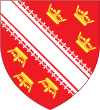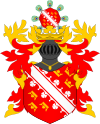Alsatian dialect
| Alsatian | |
|---|---|
| Native to | France |
| Region | Alsace |
Native speakers | (1.5 million in France cited 1987)[1] |
| Official status | |
Recognised minority language in | |
| Regulated by | No official regulation |
| Language codes | |
| ISO 639-3 | gsw (with Swiss German) |
| Glottolog | swis1247 Swiss German |
| Part of a series on |
| Alsace |
|---|
|
|
Alsatian (Alsatian and Template:Lang-gsw, literally "Alsatian German"; Template:Lang-fr; Template:Lang-de or Elsässerdeutsch) is a Low Alemannic German dialect spoken in most of Alsace, a region in eastern France which has passed between French and German control five times since 1681. A dialect of Alsatian German is spoken in the United States by so-called Swiss Amish, who migrated to the U.S. in the middle of the 19th century. The approximately 7,000 speakers are mainly located in Allen County, Indiana but also in daughter settlement elsewhere.[2]

Language family

Alsatian is closely related to other nearby Alemannic dialects, such as Swiss German, Swabian, and Markgräflerisch as well as Kaiserstühlerisch. It is often confused with Lorraine Franconian, a more distantly related Franconian dialect spoken in the northwest corner of Alsace and in neighbouring Lorraine. Like other dialects and languages, Alsatian has also been influenced by outside sources. Words of Yiddish origin can be found in Alsatian, and modern conversational Alsatian includes adaptations of French words and English words, especially concerning new technologies.
Many speakers of Alsatian could, if necessary, write in reasonable standard German. For most this would be rare and confined to those who have learned German at school or through work. As with other dialects, various factors determine when, where, and with whom one might converse in Alsatian. Some dialect speakers are unwilling to speak standard German, at times, to certain outsiders and prefer to use French. In contrast, many people living near the border with Basel, Switzerland, will speak their dialect with a Swiss person from that area, as they are mutually intelligible for the most part; similar habits may apply to conversations with people of the nearby German Markgräflerland. Some street names in Alsace may use Alsatian spellings (they were formerly displayed only in French but are now bilingual in some places, especially Strasbourg and Mulhouse).[citation needed]
Orthography
| Majuscule forms | |||||||||||||||||||||||||||||||
|---|---|---|---|---|---|---|---|---|---|---|---|---|---|---|---|---|---|---|---|---|---|---|---|---|---|---|---|---|---|---|---|
| A | B | C | D | E | F | G | H | I | J | K | L | M | N | O | P | Q | R | S | T | U | V | W | X | Y | Z | Ä | À | É | Ö | Ü | Ù |
| Minuscule forms | |||||||||||||||||||||||||||||||
| a | b | c | d | e | f | g | h | i | j | k | l | m | n | o | p | q | r | s | t | u | v | w | x | y | z | ä | à | é | ö | ü | ù |
| IPA | |||||||||||||||||||||||||||||||
| /a/, /ə/ | /b̥/ | /k/, /ɡ̊/ | /d̥/ | /e/, /eː/, /ə/ | /f/ | /ɡ̊/ | /h/ | /ɪ/ | /j/ | /k/ | /l/ | /m/ | /n/, /ŋ/ | /o/ | /p/ | /k/ | /ɾ/ | /s/ | /t/ | /ʊ/ | f | /ʋ/ | /ks/ | /Y/, /yː/, /ɪ/, /iː/ | /z/ | /ɛ/ | /ɑ/, /ɑː/ | /ɛ/ | /œ/ | /y/ | /u/ |
C, Q, and X are only used in loanwords. Y is also used in native words such as Dytschi ("German"), but is more common in loanwords.
Phonology
Consonants
Alsatian has a rather simple set of 14 consonants:
| Labial | Alveolar | Postalveolar | Palatal | Velar | |
|---|---|---|---|---|---|
| Nasal | m | n | ŋ | ||
| Stop | b̥ | d̥ | ɡ̊, kʰ | ||
| Affricate | pf | ts | |||
| Fricative | f | s | ʃ | ç | (x) |
| Sonorant | ʋ | l |
Two consonants are restricted in their distribution: /kʰ/ only occurs at the beginning of a word or morpheme, and then only if followed immediately by a vowel; /ŋ/ never occurs at the beginning of a word or morpheme.
Alsatian, like some German dialects, has lenited all obstruents but [k]. Its lenes are, however, voiceless as in all Southern German varieties. Therefore, they are here transcribed /b̥/, /d̥/, /ɡ̊/.
The phoneme /ç/ has a velar allophone [x] after back vowels (/u/, /o/, /ɔ/, and /a/ in those speakers who do not pronounce this as [æ]), and palatal [ç] elsewhere. In southern dialects, there is a tendency to pronounce it /x/ in all positions, and in Strasbourg the palatal allophone tends to conflate with the phoneme /ʃ/.
Vowels
Short vowels: /ʊ/, /o/, /ɒ/, /a/ ([æ] in Strasbourg), /ɛ/, /ɪ/, /i/, /y/.
Long vowels: /ʊː/, /oː/, /ɒː/, /aː/, /ɛː/, /eː/, /iː/, /yː/
Diphthongs
This section is empty. You can help by adding to it. (January 2011) |
Comparative vocabulary list
| English | Alsatian | High Alemannic | Standard German | Swabian German | Standard French |
|---|---|---|---|---|---|
| house | Hüüs [hyˑs] | Huus | Haus | Hous | maison |
| loud | lüüt [lyˑd̥] | luut | laut | lout | bruyant |
| people | Lit [lɪd̥] | Lüt | Leute | Leid | gens/peuple |
| today | hit [hɪd̥] | hüt | heute | heid | aujourd'hui |
| beautiful | schen [ʃeːn] | schö | schön | sche | beau |
| Earth | Ard [aˑɾd̥] | Ärd | Erde | Erd | monde |
| Fog | Nabel [naːb̥l̩] | Näbel | Nebel | Nebl | brouillard |
| water | Wàsser [ʋɑsəɾ] | Wasser | Wasser | Wasser | eau |
| man | Mànn [mɑˑn] | Maa | Mann | Mà | homme |
| to eat | assa [asə] | ässe | essen | essa | manger |
| to drink | trenka [d̥ɾəŋɡ̊ə] | trinkche | trinken | trenka | boire |
| little | klai [ɡ̊laɪ̯] | chlei | klein | kloi | petit, petite |
| child | Kind [kɪnd̥] | Chind | Kind | Kind | enfant |
| day | Däi | Dag | Tag | Dàg | jour |
| woman | Frài | Frou | Frau | Frau | femme |
Status of Alsatian in France
The constitution of the Fifth Republic states that French alone is the official language of the Republic. However, Alsatian, along with other regional languages, is recognized by the French government in the official list of languages of France. France is a signatory to the European Charter for Regional or Minority Languages but has never ratified the law and has not given regional languages the support that would be required by the charter. The policies of the Paris government have had the deliberate effect of greatly weakening the prevalence of native languages in France that are not "French." As a result, the Alsatian dialect of German has gone from being the prevalent language of the region to one in decline. A 1999 INSEE survey counted 548,000 adult speakers of Alsatian in France, making it the second most-spoken regional language in the country (after Occitan). Like all regional languages in France, however, the transmission of Alsatian is on the decline. While 43% of the adult population of Alsace speaks Alsatian, its use has been largely declining amongst the youngest generations.
References
- ^ Alsatian at Ethnologue (19th ed., 2016)

- ^ Chad Thompson: The Languages of the Amish of Allen County, Indiana: Multilingualism and Convergence, in Anthropological Linguistics, Vol. 36, No. 1 (Spring, 1994), pp. 69-91
- Template:Fr icon [1] François Héran, et al. (2002) "La dynamique des langues en France au fil du XXe siècle". Population et sociétés 376, Ined.
- Template:Fr icon [2] "L'alsacien, deuxième langue régionale de France" Insee, Chiffres pour l'Alsace no. 12, December 2002
- Template:Fr icon Brunner, Jean-Jacques. L'alsacien sans peine. ASSiMiL, 2001. ISBN 2-7005-0222-1
- Template:Fr icon Laugel-Erny, Elsa. Cours d'alsacien. Les Editions du Quai, 1999.
- Template:Fr icon Matzen, Raymond, and Léon Daul. Wie Geht's ? Le dialecte à la portée de tous La Nuée Bleue, 1999. ISBN 2-7165-0464-4
- Template:Fr iconMatzen, Raymond, and Léon Daul. Wie Steht's ? Lexiques alsacien et français, Variantes dialectales, Grammaire La Nuée Bleue, 2000. ISBN 2-7165-0525-X
External links
![]() Media related to Alsatian language at Wikimedia Commons
Media related to Alsatian language at Wikimedia Commons
- 'Hover & Hear' Alsatian pronunciations, and compare with equivalents in English and other Germanic languages.
- Euromosaic: The status of Germanic languages in France (on website of Universitat Oberta de Catalunya).
- Alsatian placenames
- Template:De icon Wörterbuch der elsässischen Mundarten
- Alsatian artists
- Template:De icon Webschnuffler, article in the Frankfurter Allgemeine Zeitung on new versions of Microsoft programs in Alsatian



